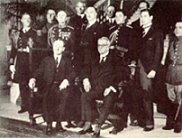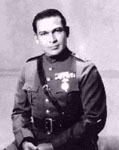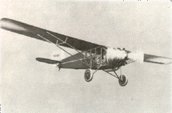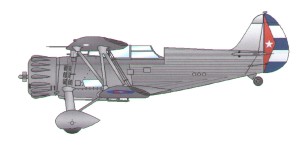

The Cuban Air Force and the 1933 RevolutionRuben Urribarres |
![]() The Revolution explodes
The Revolution explodes
 The Air Force played an important paper in the Revolution of 1933. The discontent
with the government of the dictator Machado had arrived until the soldiers. The
Colonel Sanguily and an military attache of Washington, Gimperlinck, hit the military
garrisons and organized the high officials and the aviation.
The Air Force played an important paper in the Revolution of 1933. The discontent
with the government of the dictator Machado had arrived until the soldiers. The
Colonel Sanguily and an military attache of Washington, Gimperlinck, hit the military
garrisons and organized the high officials and the aviation.
August 11 the Commanders
of several garrisons of Havana were pronounced in sedition. Machado moved to the
garrison regimental of Columbia with its special technicians of the police. Sanguily
had organized the aviation and the Regiment of Columbia but when he went to assume
the command in Columbia found that the sedition of Columbia had failed for the
presence of the police of Machado in the base.
 Los Presidentes de Cuba y Estados Unidos Gerardo Machado y Calvin Coolidge
Los Presidentes de Cuba y Estados Unidos Gerardo Machado y Calvin Coolidge
Sanguily threatened to Columbia with an bombing if they not clame to Machado that had to be gone. The War Secretary Herrera (since May of 1933) confronted by a foreign intervention decided to avoid the civil war telling him to Machado that he must to resign. Herrera went to the aviation and he said the officials that he would assume the power of the Presidency. But the aviation officials said it that this notorious Machado´s official not would resolve the problem and they not accepted it.
The Captain Torres Menier, Chief of the Aviation Corp, required the dictator Machado its renunciation, under military threat of action by the aviation, to what Machado agreed August 12, 1933, after Menier, Laborde and Martull overfligh Havana. At 3 o'clock of the afternoon of that day, Machado, the first Dictator of the Cuban Republic took an airplane to Nassau, a possession of Great Britain and he left the country for always. When the Air Force radio station began to transmit the news that Machado had gone (August 12) the masses left to seek the Machado´s loyaltyes men that take part in the crimes. Thousand persons were lynched in three months, and others escaped to the exile or were imprisoned.
![]() Organization changes of the Aviation Corp
Organization changes of the Aviation Corp
| With
the fall of the government of President Machado ended the Beam era and began the
era of Len Povey who tried to save the remnants of the Air Corp. Few days after
the fall of Machado, is produced the revolutionary movement "4 of September" ("
The Sergeant´s Revolution"), directed by the Sergeant Fulgencio Batista.
The Leader of the Air Corp Torres
Menier tries to impede personally the sublevation, without success. Batista
became the "strong man" in Cuba by the next 25 years. At the coming of the revolutionary movement "4 de Septiembre" another reorganization took place at the Air Corp, the flight line mechanics after passing mental and physical tests, were given an intensive flight training in order to become pilots. |

Fulgencio Batista |
Pablo Alonso Echevarria, Tomas Alvarez, Victor Bermúdez Nerey, Lucas Brihuegas, Florencio Ceballos, Fernando P. del Valle Díaz, Laureano García Berrocal, Belisario Hernández, Antonio Herréra Toledo, Alfredo Jiménez Alum, Juan Olivéra Hermida, Manuel Horta González, Guillermo Someillan, Antonio Soto Rodríguez, Miguel Rollo Gil, Marcelino Vásquez Rodríguez, Francisco Yanez, Guillermo Solorzano.
![]() Some Aviation Actions in 1933-34
Some Aviation Actions in 1933-34
November 8, 1933 airplanes of the Aviation Corp bombard the Presidential Palace, where was the President Grau San Martín. This Coup of the aviation fails for Army forces, but Grau of all forms is seen obliged to abandon the power in January of 1934, being reinforced the power of the Leader of the Army, of the already Colonel Batista.
 | Batista in the Columbia Camp, september of 1933. Its Coup marks the beginning of a phase of greater influence of the militaryes in Cuba |
On August of 1934 the communists announced a demonstration in the center of the city of Havana, even without the government permission. Colonel Batista then Army Commander, ordered the Air Corp to scare the demonstrators to which Povey armed his plane with 2 demolition bombs of 120 pounds (only for effects because they did not have any detonators). Descending form a height of 4000 feet flew over the heads of the communists at the Prado Avenue, in a bombing pass, when the communist saw the plane panicked and ran with fear in all directions with their signs and flags and noise equipment.
![]() The quiet decade
The quiet decade
In this 1934 arrived at Colombia an Cuban air mission of the Lieutenant Colonel Ernesto Laborde. In the year of 1935 flying over the Las Villas Province in Central Cuba Lieutenants Miguel Rollo and Lucas Brihuegas had a fatal accident. Then in honor of Brihuegas would be baptized with its name the airport of Columbia. During the graduation flight of the 1936 promotion, in 1937, while flying formation over his home town in the city Santa Clara, Province of Las Villas on a cross country to Camaguey with Corsair aircraft when one of the Corsair flown by Lieutenant Carlos Pascual Pinard flew too close Lieutenant Angel Rojas Gonzalez cutting his tail and crashed in the vicinity of his home. Captain Manuel Horta flying the last persecution aircraft a Curtiss Hawk numbered 21, had a fatal accident at Rancho Boyeros (Jose Marti Airport). His aircraft stalled while trying to make a aileron roll at low altitude during take off and crashing against a Beechcraft 17 tail number NC14404 that was parked on the apron near the runway on January 11th 1939.
1936 Aviation School
Promotion
Efrain García
D'Abrigeon, José A. Fernández Martínez, Angel González
Rojas, Francisco Gutiérrez Vásquez, Roberto Henderson Bezanilla,
Luis Insua, Carlos Pascual Pinard, Domingo Piñero Corno, Manuel Reboso
Brito, Guillermo Someillan González, Marcelino Vásquez Rodríguez.
![]() Purchases of Airplanes in 1933-39
Purchases of Airplanes in 1933-39
| To the year
1937, only remained four Corsairs and three Hawks II. A lonely transport Curtiss
Robin, perhaps an ex Cubana Airlines, was operated between October of 1935
and September of 1937, also a Bellanca Airbus 66-75 (103) flew in August
of the same year. This aircraft was armed with two-caliber .30 machine-gun, installed
on the landing gear and another in the rear of the fuselage and two positions
for 200 pounds bombs. In 1935 was bought a rare Waco S3HD-A (N°23), that was lost in 1940. |
 Curtiss Robin
Curtiss Robin |
On July of 1937 arrive to Cuba, one Stinson SR-9DD Reliant (104), 5 Curtiss Hawk CW-19R the arrived the following month. This metal monoplane received the numbers (50-51-52-53-54). Two of them were re numbered later on as (101 and 102) in one of them lost his life Lieutenant Palacios in an accident and the other was donated to the Technical School at Ceiba del Agua.
![]() Importants Flights of the Air Corp in 1936-39
Importants Flights of the Air Corp in 1936-39
First Cuban in overflight the Atlantic Ocean. January 10, 1936 the Lieutenant of the Cuban aviation Antonio Menéndez Peláez began a lonely flight Camaguey-Sevilla in remembrance of them disappeared pilot Spanish Barberán and Collar. It flew in a Lockheed 8A Sirius, baptized "4 of setiembre", a wooden airplane of with open cabine, without radio. The route was drawn doing scale in various points of Camaguey- Venezuela- Guyana- Natal (Brazil)- Dakar- Canarias- Sevilla. It arrived February 17, 1936 to the spanish airport of Tablada and was received for Francisco Franco, and other spanish illustrate figures, being becoming the first one Cuban in overflight the Atlantic Ocean.
 | The airplanes ready for take off: the Dominican "Colón", and the Cubans "La Niña", "La Pinta" and the "Santa María" |
| At the end of the decade of the 30�s there were some long range flights to participate in some air exhibitions in San Luis, Missouri. The Waco S2HD numbered 23 did the flight on March 13, 1937 and a Bellanca Airbus numbered 103 realized the same flight to San Luis on January 15th of 1938. | 
Waco S2HD. Courtesy of Chuck Acree |
A friendship flight to Mexico City took effect by 3 CW19R on September 10th 1938. Liutenants Tomas Alvarez, Jorge del Valle and Antonio Soto flew the aircraft numbered 27, 31 and 32. And later on December the same three planes numbered 50, 51 and 52 flew to Cali, Colombia to commemorate the flight that ended in disaster the year before. This time the Cuban planes were fitted with belly tanks, possibly the first time that this was realized in Latin America.
![]() The "Cuban Eight"
The "Cuban Eight"
During the year of 1936, Len Povey brought his Curtiss Hawk to the "All American Show" at Miami, Florida for acrobatic competition and by accident invented a new revolutionary and exciting maneuver.
| | To see the dynamics of the Cuban Eight, enlarge the left image |
Povey
was going to make as an extra maneuver three aileron rolls in the top of a loop.
Realizing that in the top of the loop he had 140 mph, too much speed to perform
the loops he decided to continue the loop and immediately a half roll and repeated
the maneuver in other to make a flat "8". Upon landing, James Doolitle (later
a General of great fame on account of the Tokio Raid from the Carrier Hornet)
who was one of the judges questioned Povey. Asked if that was his extra maneuver,
to what Povey replied, that it was, when asked about the name of such maneuver,
Povey casually replied "a Cuban 8". This maneuver became one of the most important
maneuvers of coordination for future pilots. Other figures derived are the "Inverted
Cuban Eight", The "Half Cuban Eight" and the "Inverted Half 8 Cuban Eight".
![]() Related articles
The Trasatlantic Flight of Menendez Pelaez
1913. Audacious Flight of Rosillo and Parlá
1933-1938, Cuban Military Aviation. The 1933 Revolution and her consequences.
Related articles
The Trasatlantic Flight of Menendez Pelaez
1913. Audacious Flight of Rosillo and Parlá
1933-1938, Cuban Military Aviation. The 1933 Revolution and her consequences.
![]() External Links
Cuban Military Forum
External Links
Cuban Military Forum
|
|
|
|
|||
